This article was co-authored by Jurdy Dugdale, RN. Jurdy Dugdale is a Registered Nurse in Florida. She received her Nursing License from the Florida Board of Nursing in 1989.
There are 10 references cited in this article, which can be found at the bottom of the page.
This article has been viewed 124,139 times.
A wound dressing helps to protect an injury from infection. However, wound dressings need to be changed every so often to make sure that the dressing is doing its job correctly. To change a wound dressing, you will need to take some time beforehand to prepare. You will also need to know how to monitor the wound after you have changed the dressing.
Steps
Preparing to Change a Wound Dressing
-
1Gather all of the necessary materials. Changing the wound dressing will be much more efficient if you do not have to go looking for materials in the middle of changing your dressing. Things to gather before you begin include:
- A cleanser to clean the wound, such as a saline solution.
- Sterile dressing, like sterile gauze or a pre-packaged dressing.
- Tape that can fasten and stabilize the wound dressing.
- Disposable gloves to protect your hand from any debris found in the wound and to protect your wound from harmful microbes on your hand.
-
2Wash your hands. This will help to remove bacteria from your hands that could transfer to the wound when you change the dressing. Hands harbor a lot of harmful microbes, thus it becomes imperative to limit the number of microbes you expose the wound to.[1]
- Wash your hands with warm water and soap for 40 seconds to a minute. The World Health Organization suggests that you wet your hands. Work up soap into a lather in your hands and then scrub your palms, the backs of your hands, each finger, and all the space in between your fingers—in that order. Rinse your hands with clean water. Dry your hands on a clean towel.[2]
Advertisement -
3Put on a pair of clean gloves. After performing the proper hand washing technique described above, you can perform wound dressing with your bare hands. However, as an added precaution, you should wear disposable gloves.[3]
- Handwashing eliminates most microbes but can leave a few bacteria behind.
Changing the Wound Dressing
-
1Remove the old dressing. To make this process easier, pour liberal amounts of water on the dressing so that the edges of the tape loosen up. You could also try wetting the bandage with a cotton ball that has been dipped in a saline solution.[4]
- You could also use an unopened, sterile bottle of water to clean the wound.
-
2Assess your wound. When you have uncovered your wound, take a look at it to see if there are any signs of infection. Note any foul smelling odor, drainage (and what color the drainage is) and the physical appearance of the wound.[5]
- It is normal to see redness and swelling during the first few days after you receive the wound, but any foul smell or draining pus, or exudate, means that your wound is infected. Report these signs to your doctor immediately.
-
3Apply the new dressing.[6] Apply an antibiotic cream to make sure the wound is protected. Cover the wound with sterilized gauze and tape the gauze down around the edges.[7]
- Do not use an antibacterial cream for an extended period of time.
Monitoring the Wound
-
1Keep the dressing clean and dry. moisture that stays on the wound can stimulate the growth of bacteria and fungus, causing the wound to become infected. If the dressing gets wet, change it.[8]
- If the dressing is soiled with blood or drainage, or becomes soiled with mud or dirt, you should change the dressing.
-
2Keep your body clean. By keeping your body clean, you can limit the number of bacteria that your wound is exposed to. However, you should consider taking a sponge bath, as soaking a wound in a bathtub is likely to expose it many microorganisms.
- You can take a shower to clean yourself, but try to limit the amount of water that gets on the wound.[9]
-
3Report any unusual changes in your wound. Call your doctor if you see signs of infection, or if any strange things occur around the wound.[10]
- Again, if you have a bad smelling odor coming from your wound, pus coming out of the wound, or excessive amounts of pain, call your doctor.
-
4See your doctor if the wound is not healing. If your wound has not begun to heal after a few days, there is most likely something wrong. Set up an appointment and meet with your doctor so that the doctor can take a look at your wound.
References
- ↑ https://www.cdc.gov/features/handwashing/index.html
- ↑ https://www.who.int/gpsc/5may/Hand_Hygiene_Why_How_and_When_Brochure.pdf
- ↑ https://www.stjude.org/treatment/patient-resources/caregiver-resources/patient-family-education-sheets/tracheostomy-care/how-to-put-on-sterile-gloves.html
- ↑ https://medlineplus.gov/ency/patientinstructions/000040.htm
- ↑ https://www.sciencedirect.com/topics/medicine-and-dentistry/wound-drainage
- ↑ https://www.nhs.uk/common-health-questions/accidents-first-aid-and-treatments/how-do-i-apply-plasters-and-other-dressings/
- ↑ Lipsky, B. (2009). Topical Antimicrobial Therapy for Treating Chronic Wounds. Seattle: Clinical Infectious Diseases. pp. 1541 – 1549.
- ↑ https://medlineplus.gov/ency/patientinstructions/000315.htm
- ↑ https://www.lhch.nhs.uk/media/1112/wound-care-discharge-advice-march-15.pdf
Expert Q&A
-
QuestionShould I change the dressing daily for a wound on a diabetic foot?
 Jonas DeMuro, MDDr. DeMuro is a board certified Pediatric Critical Care Surgeon in New York. He received his MD from Stony Brook University School of Medicine in 1996. He completed his fellowship in Surgical Critical Care at North Shore-Long Island Jewish Health System and was a previous American College of Surgeons (ACS) Fellow.
Jonas DeMuro, MDDr. DeMuro is a board certified Pediatric Critical Care Surgeon in New York. He received his MD from Stony Brook University School of Medicine in 1996. He completed his fellowship in Surgical Critical Care at North Shore-Long Island Jewish Health System and was a previous American College of Surgeons (ACS) Fellow.
Board Certified Critical Care Surgeon Most dressings are changed daily, although some are designed to stay in longer, such as an alginate, and some dressings need more frequent changes if the wound is highly infected. Follow your doctor's instructions on the proper frequency for the optimal outcome.
Most dressings are changed daily, although some are designed to stay in longer, such as an alginate, and some dressings need more frequent changes if the wound is highly infected. Follow your doctor's instructions on the proper frequency for the optimal outcome. -
QuestionCan I wrap my wound in plastic while I am taking a shower?
 Jurdy Dugdale, RNJurdy Dugdale is a Registered Nurse in Florida. She received her Nursing License from the Florida Board of Nursing in 1989.
Jurdy Dugdale, RNJurdy Dugdale is a Registered Nurse in Florida. She received her Nursing License from the Florida Board of Nursing in 1989.
Medical Review Board Yes, you can, and there are special plastic covers made for this that you can purchase from your local drug store.
Yes, you can, and there are special plastic covers made for this that you can purchase from your local drug store. -
QuestionShould we put anything inside the wound?
 Jurdy Dugdale, RNJurdy Dugdale is a Registered Nurse in Florida. She received her Nursing License from the Florida Board of Nursing in 1989.
Jurdy Dugdale, RNJurdy Dugdale is a Registered Nurse in Florida. She received her Nursing License from the Florida Board of Nursing in 1989.
Medical Review Board Never put anything directly into a wound or else you could cause further damage.
Never put anything directly into a wound or else you could cause further damage.
About This Article
To safely change a wound dressing, be sure to first douse your original bandage with water to make removing it a bit easier. When the bandage is off, take a moment to assess your wound - is there any sign of infection? Foul smell? Draining pus? If so, see a doctor immediately. If not, apply povidone iodine to the wound with a cotton ball, followed by antibacterial cream. When you're finished, cover the wound with sterile gauze and tape the gauze down. For more health advice, like how to monitor any changes to your wound, keep reading.
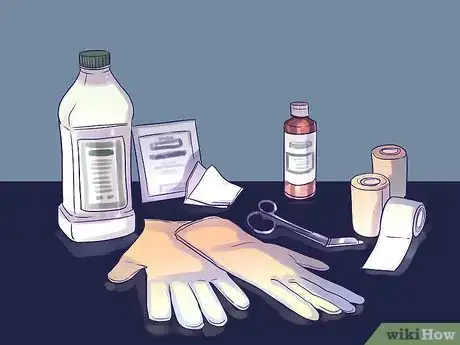
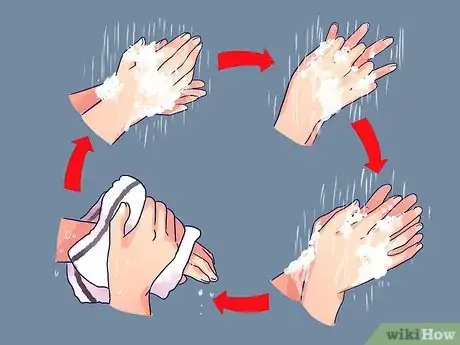

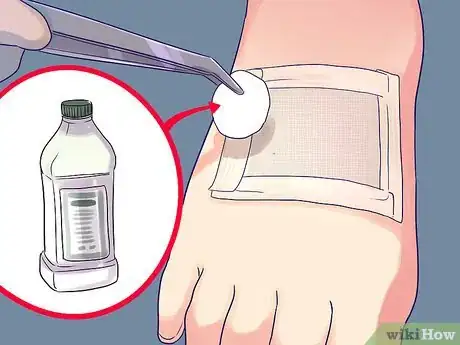
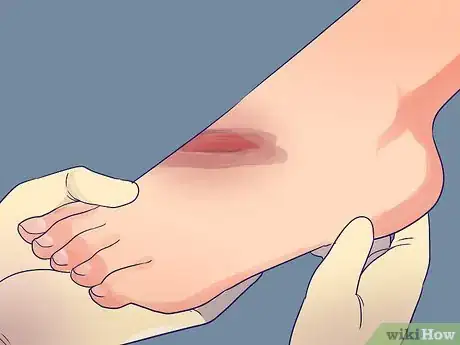
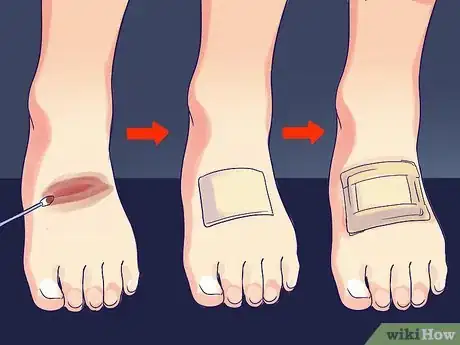
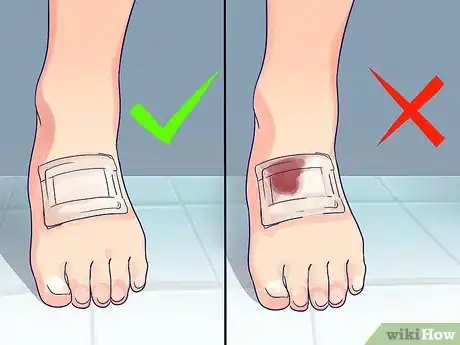

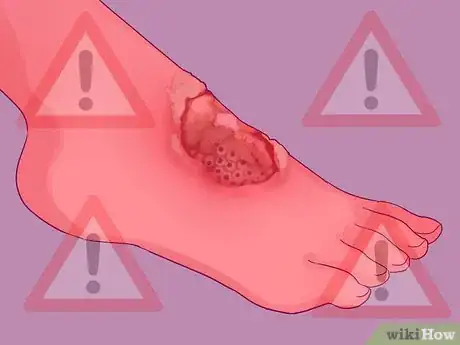



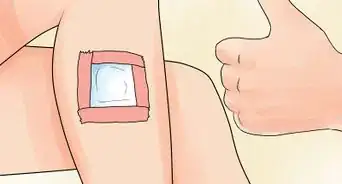






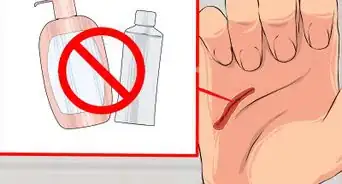



















































Medical Disclaimer
The content of this article is not intended to be a substitute for professional medical advice, examination, diagnosis, or treatment. You should always contact your doctor or other qualified healthcare professional before starting, changing, or stopping any kind of health treatment.
Read More...